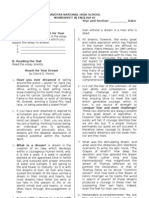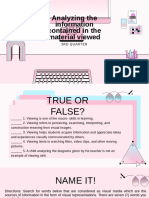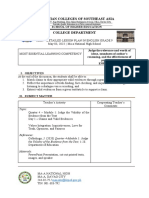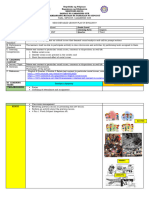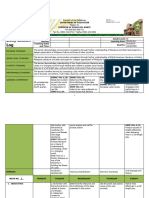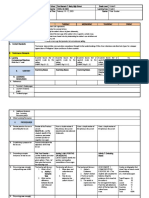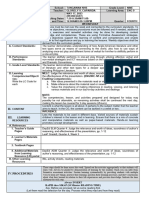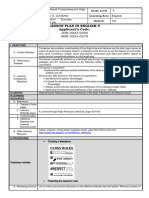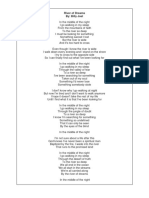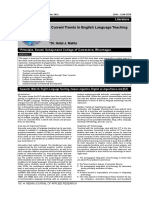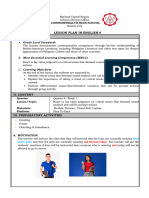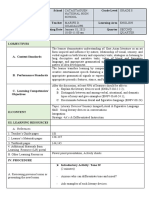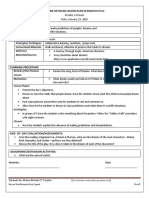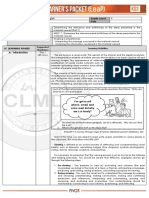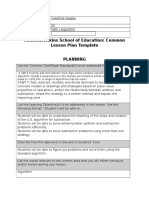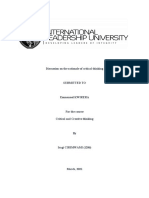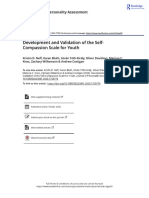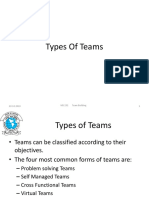Le MDL q3 Eng9 Lesson 2 Week 4
Uploaded by
Louraine BantillanLe MDL q3 Eng9 Lesson 2 Week 4
Uploaded by
Louraine BantillanSchool Liliw National High School Grade Level 9
LESSON EXEMPLAR Teacher Abigail P. Asunto Learning Area English
ONLINE DISTANCE
Teaching Date Week 4 Quarter 3
LEARNING
Teaching Time 1:00 – 2:00 No. of Days 5
I.OBJECTIVES At the end of the lesson, learners are expected to:
a. Identify the relevance and truthful ideas presented in material viewed;
b. Explain the relevance and truthful ideas presented in material viewed;
c. Infer if the ideas presented are relevant or relevant and/or truthful or untruthful to
the lives of Filipino youth; and
d. Determine the relevance and truthfulness of the ideas presented in the material
viewed.
A. Content The learner demonstrates understanding of how Anglo-American literature and other text
Standards types serve as means of enhancing the self; also how to use processing, assessing,
summarizing information, word derivation and formation strategies, appropriate word order,
punctuation marks and interjections to enable him/her to participate actively in a speech
choir.
B. Performance The learner actively participates in a speech choir through using effective verbal and non-
Standards verbal strategies based on the following criteria: Focus, Voice, Delivery, Facial
Expressions, Body Movements/ Gestures and Audience Contact.
C. Most Essential Determine the relevance and truthfulness of the ideas presented in the material viewed.
Learning
Competencies
(MELC)
D. Enabling Interpret the truthful and relevant ideas shown in the graph
Competencies
II. CONTENT Determining the relevance and truthfulness of the ideas presented in the material viewed.
III. LEARNING
RESOURCES
A.References
a. Teacher’s Guide
Pages
b. Learner’s Pages 23-36
Material Pages
c. Textbook Pages
d. Additional Pictures from google
Materials from http://youtube.com/watch?v=dxvBgwGVtvM
Learning
Resources
B. List of Learning
Resources for
Development and
Engagement Activities
IV.PROCEDURES
A. Introduction
(DAY 1 30 mins) We are living in a visual world. The advent of the internet and the digital revolution, the widespread
availability of mobile devices that enables us to easily capture still and moving images, the appearance of
video-sharing sites such as YouTube, and the proliferation of social media networks such as Instagram and
Facebook with users primarily uploading visual content, have all led to an unprecedented increase in
the number of people using the internet.
The majority of texts young people are encountering and creating are multimodal. A multimodal
document is one in which the meaning is conveyed by multiple modes, such as written text, audio, still images,
moving images, motion, use of space, and so on. Photos, slideshows, and web sites are examples of digital
multimodal texts, while theater, storytelling, and dancing are examples of live multimodal texts.
Look at the illustration below and answer the guide questions that follow. Write your answer in your pad
paper.
I’ve got a cellphone, email, and voice mail. But why am I so lonely?
1. This man has all the modern gadgets, yet he is still lonely, why do you think this is
so?
2. What is general rule in life depicted?
Most of the time, you are asked to read, write, speak, and listen in various lessons in the classroom. But
what about the fifth skill?
Viewing is defined as an active process of attending and comprehending visual media, such as television,
advertising images, films, diagrams, symbols, photographs, videos, drama, drawings, sculpture, and
paintings.
It is necessary to remember that the viewing process is just as crucial as the listening and reading
processes. You should be aware that effective, engaged viewers go through the following steps:
1. Pre-viewing - You prepare to view by activating your schema (the prior knowledge you bring to the
study of a topic or theme), anticipating a message, predicting, speculating, asking questions, and
setting a purpose for viewing.
2. During viewing - You view the visual text to understand the message by seeking and checking
understanding, making connections, making and confirming predictions and inferences,
interpreting and summarizing, pausing and reviewing, and analyzing and evaluating. Your
understanding should be monitored by connecting to your schema, questioning, and
reflecting.
3. After viewing - You are given opportunities to respond to visual texts in an intimate,
critical, and creative way. You respond by reflecting, analyzing, evaluating, and
creating.
B. Development LEARNING TASK 1
(Day 2) Look at the picture. What could be the cause of these phenomena? Write 3-5 sentences about it. Write your
answers in your pad paper.
LEARNING TASK 2
Visualize yourself in an emergency situation. How do you respond to such? Who do you call
for help? For each critical situation below, indicate your life-saving solution. Cite your
opinion for giving such a solution. Write your answers in your pad paper.
LEARNING TASK 3
Study and analyze the given situation. Write your answer on your pad paper.
1. Analize the nutritional facts of the food on the left. It is to be served by the
mother to her six-month old baby. Would you recommend this food to her?
Why or why not? Justify your answer.
2. You and your friends have been waiting for the sequel of your most
favorite movie-series. However, you found out that the movie is
now restricted to an audience 18 years and above. Your friends who
are all under 18 presented fake IDs just to see the movie. Would you
go with them?
C. ENGAGEMENT LEARNING TASK 4
( DAY 3)
Read the poem “The Telephone” by Edward Field. Interpret the message of the poem. Answer the
guide questions on the table that follows. Write your answers in your pad paper.
The Telephone
By: Edward Field
My happiness depends on an electric appliance
And I do not mind giving it so much credit
With life in this city being what it is
Each person separated from friends
By a tangle of subways and buses
Yes my telephone is my joy
It tells me that I am in the world and wanted
It rings and I am alerted to love or gossip
I go comb my hair which begins to sparkle
Without it I was like a bear in a cave
Drowsing through a shadowy winter
It rings and spring has come
I stretch and amble out into the sunshine
Hungry again as I pick up the receiver
For the human voice and the good news of friends
1. What is the predominant feeling of the speaker in the lines? Why does he feel
that way?
2. Why are friends disconnected?
3. How does the speaker justify his joy of having a telephone?
4. What value do people give to the telephone when he has the access to it
5. What does the speaker hunger for? Is he capable of connecting to the world?
Explain.
LEARNING TASK 5
Consider this situation as depicted in the picture: A student received academic recognition from the school.
How do you think a supportive parent would speak to the child? Create a dialogue between a student
breaking the good news about her academic achievement to her mother.
RUBRICS
Criteria 5 pts 3 pts 2pt. Needs
Excellent Good Improvement
Content Contents and Contents and Contents and
dialogues are dialogues are quiet dialogues are not
coherent are relevant coherent and relevant coherent and relevant
to given situation. to a given situation to a given situation
Creativity and clarity Ideas are well- Ideas are pretty well- Ideas are somewhat
organized. Dialogues organized. Dialogues confusing. Dialogues
contain many creative contain some creative do not seem to have
details and shows details and shows used much
clear understanding of good understanding of imagination and
the situation the situation shows fair
understanding in the
situation
Grammar, punctuation There are no There are few There are more than a
and spelling grammar, grammar, few grammar,
capitalization and capitalization and capitalization and
punctuation and punctuation and punctuation and
spelling error. spelling error spelling error
Total : 30 points
D. ASSIMILATION
(DAY 4) VIEWING HELPS YOU
Develop the knowledge and skills to analyze and evaluate visual
text and multimodal texts that use visuals.
Acquire information and appreciate ideas and experiences
visually communicated by others.
Slowdown, reflect and think about the images you are
seeing and develop the knowledge and skills to analyze and
evaluate visual texts and multimedia texts that use visuals.
Therefore, viewing is important because as you are dealing with mainly multimodal texts, you need to
understand them and to become more effective, active, and critical viewers to be able to participate fully in
society.
V. ASSESSMENT Read the following statements. Decide whether you agree or disagree on the given statements. Write A if you
(15 mins) agree and DA if you disagree. Write your answers in your pad paper.
1. You gain expertise and skills for analyzing and evaluating visual texts and multimodal texts that use
visuals through viewing.
2. A multimodal text is one where the meaning is communicated by more than one mode – e.g., written
text, audio, still pictures, moving pictures, gesture, use of space, etc.
3. Digital multimodal texts can include, for example, theatre, storytelling, and dance.
4. Post-viewing prepares you to view by activating your schema, anticipating a message, predicting,
speculating, asking questions, and setting a purpose for viewing.
5. Viewing helps you build the expertise and skills to interpret and assess visual texts and interactive
texts that use visuals by slowing down, reflecting, and thinking about what you're seeing.
VI. REFLECTION Directions: Reflect on what you learned on this lesson about viewing by completing the
( 10 mins) statements below.
1. My journey through this lesson enabled me to learn
______________________________.
2. It made me realize that
_________________________________________________________.
3. I therefore commit to
___________________________________________________________.
Prepared by:
ABIGAIL P. ASUNTO
You might also like
- English9_q4_CLAS4_Reacting on Critical Issues_v7 - Carissa CalalinNo ratings yetEnglish9_q4_CLAS4_Reacting on Critical Issues_v7 - Carissa Calalin12 pages
- Tonga Lim Siao Sr. Integrated School Daily Lesson Plan in English 9No ratings yetTonga Lim Siao Sr. Integrated School Daily Lesson Plan in English 911 pages
- Judge The Relevance and Worth of Ideas DAY 2No ratings yetJudge The Relevance and Worth of Ideas DAY 217 pages
- Eng9 Q3 M2 W6 NonverbalComminucationStrategiesThroughTechnology V5No ratings yetEng9 Q3 M2 W6 NonverbalComminucationStrategiesThroughTechnology V519 pages
- Analyzing The Information Contained in The Material ViewedNo ratings yetAnalyzing The Information Contained in The Material Viewed15 pages
- Judging The Effectiveness of The Presentation100% (1)Judging The Effectiveness of The Presentation45 pages
- DLL Judge The Validity of The Evidences Listened ToNo ratings yetDLL Judge The Validity of The Evidences Listened To1 page
- Daily Lesson Log: Department of Education Division of Davao Del NorteNo ratings yetDaily Lesson Log: Department of Education Division of Davao Del Norte48 pages
- Content Standard:: Lesson Plan in English 9No ratings yetContent Standard:: Lesson Plan in English 95 pages
- Compilation of Activities IN: Philippine LiteratureNo ratings yetCompilation of Activities IN: Philippine Literature6 pages
- Expression of Agreement Lesson Plan in English 9No ratings yetExpression of Agreement Lesson Plan in English 92 pages
- DLP 15 - Reacting To Lay Value of Judgement On Critical IssuesNo ratings yetDLP 15 - Reacting To Lay Value of Judgement On Critical Issues5 pages
- Analyzing Lit. As A Means of Understanding Unchanging Values100% (1)Analyzing Lit. As A Means of Understanding Unchanging Values1 page
- FINAL Q4 Week 1 2024 JUDGE THE RELEVANCE AND WORTH OF IDEAS SOUNDNESS OF AUTHORS REASONING AND THE EFFECTIVENESS OF THE PRESENTATION 1No ratings yetFINAL Q4 Week 1 2024 JUDGE THE RELEVANCE AND WORTH OF IDEAS SOUNDNESS OF AUTHORS REASONING AND THE EFFECTIVENESS OF THE PRESENTATION 112 pages
- English 9 Q2LAS1 - Coping With ChallengesNo ratings yetEnglish 9 Q2LAS1 - Coping With Challenges4 pages
- Current Trends in English Language Teaching: Research Paper LiteratureNo ratings yetCurrent Trends in English Language Teaching: Research Paper Literature3 pages
- English 9 Quarter 2 Lesson Week 1 Making ConnectionsNo ratings yetEnglish 9 Quarter 2 Lesson Week 1 Making Connections84 pages
- Budget of Work in Grade 9 English First Quarter (2020-2021)No ratings yetBudget of Work in Grade 9 English First Quarter (2020-2021)2 pages
- 6 Final English Grade 9 Week 6 Second QuarterNo ratings yet6 Final English Grade 9 Week 6 Second Quarter10 pages
- WLP-Gr-9-Judging-The-Effectivenes-of-PresentationNo ratings yetWLP-Gr-9-Judging-The-Effectivenes-of-Presentation3 pages
- DLL Vuca Raisin in The Sun Week 4 October 21 25100% (2)DLL Vuca Raisin in The Sun Week 4 October 21 2512 pages
- Millicent Atkins School of Education: Common Lesson Plan TemplateNo ratings yetMillicent Atkins School of Education: Common Lesson Plan Template7 pages
- Perspective Matters: Sharing of Crisis Information in Social MediaNo ratings yetPerspective Matters: Sharing of Crisis Information in Social Media9 pages
- PHIL 244-11 Essay 2 (Iain) Selman Harun Canbol (1) FinalNo ratings yetPHIL 244-11 Essay 2 (Iain) Selman Harun Canbol (1) Final6 pages
- Examining The "Attractiveness Halo Effect"No ratings yetExamining The "Attractiveness Halo Effect"5 pages
- The Witch and the Clown Two Archetypes of Human Sexuality 2nd Edition Ann Belford Ulanov - Own the ebook now with all fully detailed chapters100% (1)The Witch and the Clown Two Archetypes of Human Sexuality 2nd Edition Ann Belford Ulanov - Own the ebook now with all fully detailed chapters63 pages
- Discussion On The Rationale of Critical ThinkingNo ratings yetDiscussion On The Rationale of Critical Thinking4 pages
- 09 - GSE - LO - YoungLearners - Web - May 2018 PDFNo ratings yet09 - GSE - LO - YoungLearners - Web - May 2018 PDF40 pages
- Table of Stylistic Devices - Posters OnlyNo ratings yetTable of Stylistic Devices - Posters Only5 pages
- 5 Neff Et Al (2020) - Self Compassion Scale For YouthNo ratings yet5 Neff Et Al (2020) - Self Compassion Scale For Youth15 pages
- Lecture 3 Social Dynamics Leith Sharp-1No ratings yetLecture 3 Social Dynamics Leith Sharp-178 pages
- Risk Management and Resilience: Derin Ural College of Engineering University of MiamiNo ratings yetRisk Management and Resilience: Derin Ural College of Engineering University of Miami12 pages
- D'Souza Group: Performance Management SystemNo ratings yetD'Souza Group: Performance Management System14 pages





